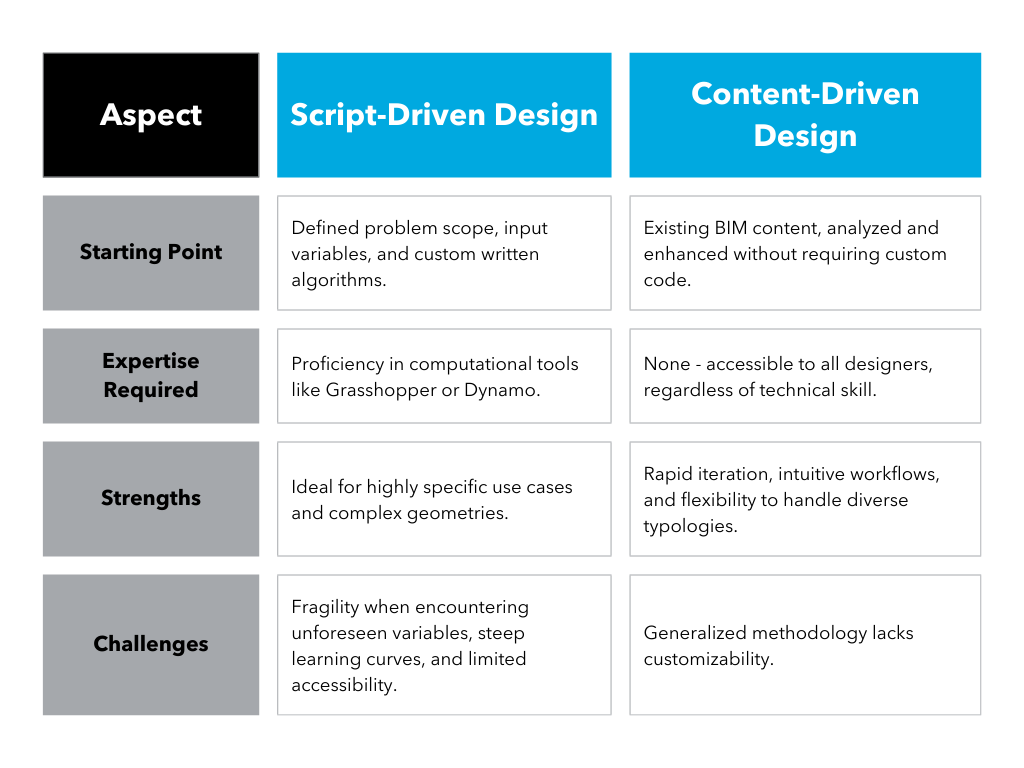The Future of Computational Design: Where Scripts and Content Converge
Architects and engineers face growing pressure to design faster and more flexibly while meeting the complexity of today’s projects. Computational tools with script-driven workflows, such as Grasshopper and Dynamo, have helped achieve these goals by automating repetitive tasks and enabling highly customized solutions. But these tools are not without limitations. Scripts require specialized expertise, are often fragile, and can exclude the majority of a design team from direct participation.
What if there was a way to democratize these capabilities—putting the power of automation into more hands?
Consider the content-driven approach that Skema represents: a methodology that reimagines how architects and engineers use design tools by leveraging existing BIM content instead of requiring custom code. This approach enables designers to intuitively and quickly generate site and building designs, with an iterative process that supports rapid analysis of design options and prototypes.
Data Center Design Case Study: Reduce Design Time Without Compromising Quality
While the script-versus-content debate applies to all building typologies – from multifamily residential to schools, hospitality, and beyond – one compelling example comes from HED, a firm known for their innovative approach to hyperscale and colocation data centers.
The firm aims to get ahead of the ever-increasing expectations from clients to deliver quickly and efficiently. As their team explains:
“Our current process meets client timelines and goals, but we are exploring computational tools that could increase design speed, generate more iterations quickly, and even surprise us with solutions beyond what a designer might initially conceive.”
Amanda Gioia, a computational designer at HED, is leading those efforts. I recently spoke with Amanda, where she reflected on her experience with Skema’s content-driven methodology:
“With the scripting and computational design approach, you need a lot of knowledge to get started. And then chances are that the tool that you develop will maybe only be applicable to a handful of projects. In contrast, Skema will allow any beginner to be able to engage with the tool. And then it can be applied to many projects.”
Amanda’s insights highlight how content-driven approaches can make sophisticated design tools accessible to more designers, not just those with computational expertise. Learn more by checking out our case study on how Amanda used Skema for data center design.
Script vs Content: Two Approaches to Design Automation
Both script-driven and content-driven methodologies rely on graphs and other data structures to automate design workflows and produce results. However, they differ in their starting points and accessibility. Let’s compare:
The Best of Both Worlds: The Hybrid Approach
As the demands of architectural design grow, the future likely lies in a hybrid methodology that combines the strengths of both approaches.
I envision a technology stack in the near future where Skema’s content-driven methodology serves as a flexible foundation for design teams, while computational experts can still create custom solvers and inject them into workflows for specialized requirements. This combination ensures:
Faster iterations across a broader team.
Seamless adaptability to unforeseen variables.
The ability to tackle both generalized and highly specific project requirements.
Reimagining Design Workflows, Together
Architectural design is at a turning point. By combining Skema’s content-driven approach with script-driven computational workflows, design teams can achieve faster timelines, higher-quality results, and more inclusive collaboration.
We’re rethinking what’s possible in architecture, and we’re hard at work creating integrated, high-value tool chains. We are working with specific customers in ‘Skunkworks’ mode on specific cases that will light the way forward. If your team is looking to make better earlier decisions that reduce downstream waste and increase success rates, let’s connect to explore how Skema can help meet your unique design challenges.



